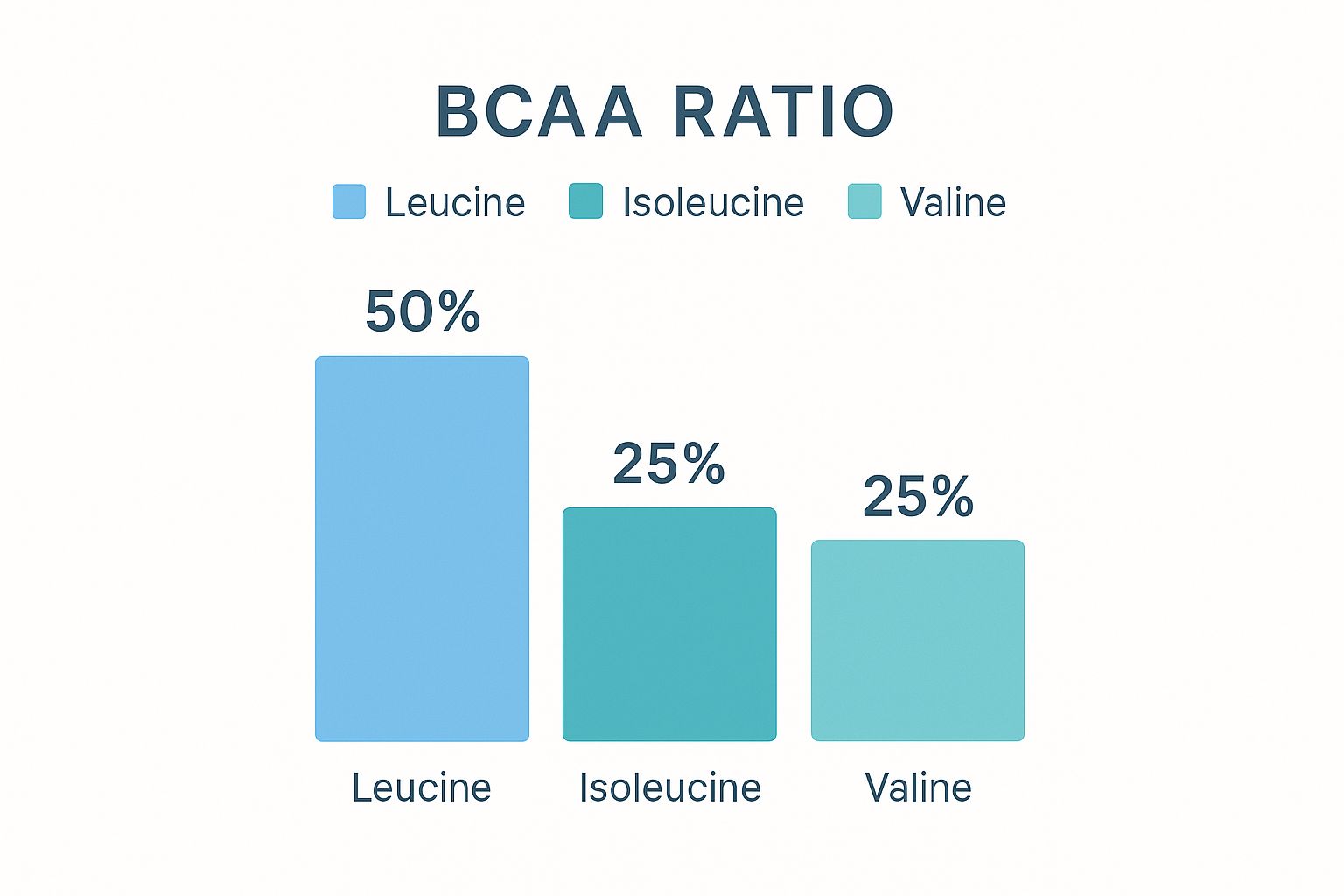Think of amino acids as the dedicated construction crew your body calls in after a tough workout. Every time you push your limits, you create tiny micro-tears in your muscle fibers. This isn't a bad thing—it's the signal your body needs to rebuild bigger and stronger. But that crew needs building materials, and that's exactly what amino acids are.
They are the fundamental components of protein, and without them, the repair process grinds to a halt.
The Nitty-Gritty: How Amino Acids Actually Repair Muscle
Let's stick with the construction analogy. If protein is the finished building, amino acids are the individual bricks, mortar, and steel beams. When your muscles are damaged after a workout—say, from a training session inspired by your favorite anime hero—your body sends out a call for these raw materials to patch things up and reinforce the structure.
This is where amino acids for muscle recovery step in. A steady supply ensures the renovation job gets done right, preventing delays in your progress and helping you come back even stronger for your next session.
Essential vs Non-Essential Aminos: What’s the Difference?
To really get this, we need to break down amino acids into two main teams:
- Essential Amino Acids (EAAs): There are nine of these, and your body can't make them on its own. They are the non-negotiables. You have to get them from food or supplements.
- Non-Essential Amino Acids: Your body can produce these itself, so while they're still important for overall health, they aren't as critical to get from your diet.
For anyone serious about making gains, ensuring you have enough EAAs, particularly around your workouts, is a total game-changer. It’s like making sure your construction crew has a full supply of premium materials right when they need them. This is how you optimize recovery and see real results. Many of the best supplements for muscle growth are built around providing these key ingredients.
To make this even clearer, let's break down which amino acids fall into which category and what they do.
Essential vs Non-Essential Amino Acids for Recovery
This table gives you a quick snapshot of the two main types of amino acids and why the "essential" ones are so critical for anyone looking to build muscle and recover faster.
| Amino Acid Type | Key Examples | Primary Role in Recovery |
|---|---|---|
| Essential (EAAs) | Leucine, Isoleucine, Valine (the BCAAs) | Directly stimulate muscle protein synthesis, reduce muscle soreness, and prevent breakdown. |
| Non-Essential | Glutamine, Alanine, Arginine | Support immune function, energy production, and overall cellular repair. |
As you can see, while both are important, the EAAs are the superstars when it comes to directly building and repairing muscle tissue after exercise.
The core of getting stronger isn't just the workout; it's the repair process that follows. By providing the right amino acids, you're not just recovering—you're supercharging the adaptation that leads to real gains. This whole process is called muscle protein synthesis.
This is why you'll often see specific amino acids highlighted in pre-workout formulas like ours at Otaku Pump. The branched-chain amino acids (BCAAs)—a special trio of EAAs—are especially important. Research has shown that one BCAA in particular, leucine, acts like a key that turns on the engine for muscle growth.
Supplementing with these aminos helps you build lean mass more effectively and protects your hard-earned muscle from being broken down for energy. You can get into the science behind these metabolic pathways and see just how powerful they are for your recovery.
Why BCAAs Are Your Recovery Powerhouse
When we talk about essential amino acids, there's a special trio that gets all the attention for muscle recovery—and for good reason. They are Leucine, Isoleucine, and Valine.
Together, they're known as Branched-Chain Amino Acids, or BCAAs, and they're basically the special forces unit for repairing your muscles.
What makes them so unique? Their chemical structure lets them take a shortcut. They skip the usual processing line in the liver and go straight to your muscle tissue. This means they get to work almost instantly, right where you need them, to start the repair process after a tough workout.
Think of it as an express delivery right to your muscles' doorstep. While other aminos are stuck in traffic, BCAAs have a VIP pass, arriving at the construction site immediately to start rebuilding.
The Dynamic Trio of Muscle Repair
Each BCAA has its own special job, but they work together like a well-oiled machine to protect muscle, fight fatigue, and speed up growth. Getting to know their roles shows you why they’re non-negotiable in any serious pre-workout formula.
-
Leucine: The Initiator
This is the team captain. Leucine is the main signal that flips the "on" switch for muscle protein synthesis, telling your body it's time to repair and rebuild. -
Isoleucine: The Energy Manager
This amino helps manage your blood sugar and pushes glucose into your muscle cells. It’s all about providing the fuel your muscles need to perform and recover effectively. -
Valine: The Protector
Valine plays defense. It helps prevent muscle breakdown (catabolism), which is especially important during intense training or when you’re cutting calories. It’s all about protecting the muscle you’ve worked so hard to build.
Knowing what these aminos do is a game-changer for your progress. When you're picking a supplement, it’s always a good idea to learn how to read supplement facts to make sure you're getting the right amounts of these key players.
Less Soreness, More Performance
One of the first things you'll notice with BCAAs is how they take the edge off Delayed Onset Muscle Soreness (DOMS). By feeding your muscles these crucial building blocks, you can seriously reduce those post-workout aches. That means getting back to your training faster and more consistently.
But it’s not just about feeling better. It's about real, measurable gains in the gym.
A recent clinical trial showed that athletes taking 9 grams of BCAAs daily before and after training had significant boosts in their rate of force development. In simple terms, their explosive muscle strength shot up compared to those taking a placebo.
This isn't magic; it's just efficient muscle function. You’re giving your body exactly what it needs to not just repair itself, but to rebuild stronger than before. If you're into the science, you can read the full research on BCAA performance benefits and see the data for yourself.
Exploring Other Key Recovery Aminos

While the BCAA trio gets most of the glory in the world of amino acids for muscle recovery, a smart strategy always includes a strong supporting cast. Think of it like your favorite shonen anime—the protagonist is a powerhouse, but they need their trusted crew to take down the final boss. When it comes to your muscles, two of those crucial allies are Glutamine and Beta-Alanine.
These compounds aren't just BCAA clones. They bring their own unique abilities to the fight, tackling different angles of post-workout stress and fatigue. Adding them to your stack is about covering all your bases, ensuring you’re set up for both peak performance and a faster bounce-back.
The Role of Glutamine in Recovery
Glutamine is the most plentiful amino acid found in your body, and its job goes way beyond simple muscle repair. A really tough training session can drain your glutamine stores, which is bad news for your immune system and your recovery timeline.
Supplementing with Glutamine helps keep those levels topped off. This supports your body's natural defenses and helps you avoid that "run-down" feeling you can get from constantly pushing your limits. It’s particularly well-known for helping dial down muscle soreness, which lets you get back to training hard, sooner.
Glutamine is considered a conditionally essential amino acid. This means that while your body can normally make enough, the demand skyrockets during intense physical stress—like a heavy lifting session—making supplementation a smart move for serious athletes.
Studies back this up, showing that glutamine can help lower the markers of muscle damage after a workout. This is just one piece of the puzzle, but it shows how specific nutrients can work together to get you back to 100%.
Beta-Alanine and Pushing Past Your Limits
If Glutamine is your post-workout recovery specialist, think of Beta-Alanine as your in-the-moment performance booster. It works by cranking up your muscle carnosine levels. Carnosine acts as a buffer against the acid that builds up during high-intensity sets—the stuff that causes that all-too-familiar burn and forces you to stop.
What does that mean for you? It means you can grind out those last few reps that really count for muscle growth. By holding off fatigue, Beta-Alanine lets you increase your total training volume over time, which is a fundamental driver of gains.
A well-formulated pre-workout, like the ones from Otaku Pump, will often combine these aminos with BCAAs and other proven ingredients like creatine. If you want to see how these elements create a powerful synergy, check out our guide that answers the question, what is creatine monohydrate? This all-in-one approach gives your body everything it needs to go all out in the gym and recover like a pro.
Timing Your Amino Acids for Maximum Effect
Knowing which amino acids to take is a huge step, but understanding when to take them is what truly unlocks their potential. For years, the fitness world was obsessed with the idea of a strict 30-minute "anabolic window" post-workout. While getting nutrients in quickly is definitely a good thing, we now know the story is a bit more flexible.
The real goal is to keep a consistent supply of these muscle-building blocks in your bloodstream, ready for when your body needs them. This means thinking about your nutrition as a complete cycle around your training: before, during, and after. By timing your intake strategically, you can prime your muscles for a tough session, sustain energy throughout, and kickstart the repair process the second you finish your last rep.
Pre-Workout Priming
Think of taking amino acids before you train as giving a construction crew their materials before they start knocking down walls. When you take them 30-60 minutes pre-workout, they’re already circulating in your system, acting like a protective shield for your muscle tissue right when the stress of lifting begins.
This simple step can significantly reduce how much muscle protein gets broken down during intense exercise. In other words, you protect the gains you’ve already worked so hard for. A solid pre-workout, like one from a dedicated brand such as Otaku Pump, often combines these essential aminos with performance boosters to set you up for success on both fronts.
Intra-Workout and Post-Workout Fuel
Sipping on an amino acid drink during your workout (intra-workout) is a great strategy for fighting off fatigue and maintaining performance, especially if you’re in for a long, grueling session. But for most people, the most crucial timing is immediately after you train. This is when your muscles are like sponges, ready to soak up nutrients.
Getting a fast-absorbing source of amino acids in right after your workout signals your body to immediately switch from breakdown mode to repair mode. This quick replenishment helps lessen muscle soreness and ensures the rebuilding process starts without a hitch, turning all that effort into real results.
The optimal 2:1:1 ratio of BCAAs is the gold standard for a reason—it's designed to maximize muscle protein synthesis. Leucine is the main trigger, while Isoleucine and Valine play crucial supporting roles in energy and muscle preservation.
This infographic shows exactly what that ideal 2:1:1 BCAA ratio looks like, with Leucine being the star of the show.

As you can see, Leucine makes up a full 50% of the blend. It's the key that turns on the muscle-building machinery. To make sure you’re hitting that switch effectively, a good rule of thumb is to aim for at least 2-3 grams of Leucine in every serving of your post-workout amino supplement.
Choosing the Right Amino Acid Supplement
Walking into the supplement aisle can feel like navigating a minefield. With dozens of tubs all decked out in flashy labels and bold promises, how do you sort the science from the hype? Let's cut through the noise and figure out what actually makes a good amino acid supplement for muscle recovery.
First things first, flip that tub around and check the BCAA ratio. The science is pretty clear on this one: the 2:1:1 ratio of Leucine to Isoleucine and Valine is the industry gold standard for a reason. This specific blend ensures you have enough Leucine, the all-star amino, to properly kickstart muscle protein synthesis—the engine of your entire recovery process.
Look Beyond the Basics
A solid BCAA profile is a great start, but a truly top-tier pre-workout formula doesn't stop there. The best supplements create a powerful team of ingredients that work together, boosting both your performance in the gym and your recovery afterward.
Keep an eye out for these heavy hitters on the ingredient list:
- Beta-Alanine: Think of this as your fatigue-fighter. It helps reduce that acidic burn you feel during tough sets, letting you squeeze out those last few reps that really count for growth.
- Glutamine: This is your go-to for bouncing back faster. It plays a huge role in minimizing muscle soreness and helps shore up your immune system, which can take a beating from intense training.
- Citrulline Malate: Known for improving blood flow, this ingredient helps get crucial nutrients—like those amino acids you just drank—delivered to your hard-working muscles more efficiently.
The biggest red flag you can find on a supplement label is a "proprietary blend." This is just a sneaky way for companies to hide the exact dose of each ingredient. If you can't see precisely what you're getting, you have no idea if it's an effective amount. Always insist on a fully transparent label.
The All-in-One Advantage
Let's be real, juggling multiple supplement tubs is a hassle and can get pricey fast. This is where a well-formulated, all-in-one pre-workout can be a game-changer. A smart formula like Otaku Pump bundles performance enhancers and recovery-focused aminos into one scoop, giving your body everything it needs without the guesswork.
Finally, don't forget about the simple things: flavor and mixability. If you have to choke down your pre-workout, you're not going to stick with it. Consistency is everything when it comes to results, so finding a supplement that actually tastes good and dissolves without clumps is more important than you might think. Options like the unique, anime-inspired flavors from Otaku Pump can make your recovery routine a habit you actually look forward to.
Still Have Questions About Amino Acids?
Even when you've got a solid plan, a few questions always pop up as you dial in your supplement routine. Let's tackle some of the most common things people ask about using amino acids for muscle recovery. We'll give you clear, straightforward answers so you can supplement with confidence.
If I Eat Enough Protein, Do I Still Need Aminos?
This is a great question. While a high-protein diet is absolutely the foundation of your recovery, think of free-form amino acid supplements as a strategic shortcut.
Whole protein from food—like chicken, eggs, or whey—is like a long, tangled pearl necklace. Your body has to spend time digesting it and breaking it down into individual pearls (amino acids) before it can use them.
Amino acids in a pre-workout formula, on the other hand, are like a handful of loose pearls, ready to be used instantly. Taking them around your workout gives your body immediate access to these building blocks, kickstarting the repair process long before your post-workout meal is even digested.
What’s the Real Difference Between BCAAs and EAAs?
This is a huge point of confusion for a lot of people, but it's pretty simple when you break it down. The three Branched-Chain Amino Acids (BCAAs) are just one part of the bigger team of nine Essential Amino Acids (EAAs).
- BCAAs (Leucine, Isoleucine, Valine): Think of these as the foremen on a construction site. They're the ones who signal the start of muscle protein synthesis—they basically shout, "Time to build!"
- EAAs (All nine essential aminos): These are the actual bricks, mortar, and wood needed for the construction project. They're the raw materials your body uses to build new muscle tissue.
So, while BCAAs are great for flipping the "on" switch for muscle growth, you still need all the EAAs present to actually get the job done. That's why high-quality formulas, like those in Otaku Pump's pre-workouts, include a full spectrum to make sure you're not just sending the signal, but also providing all the necessary materials.
Should I Bother Taking Amino Acids on Rest Days?
Definitely. Muscle recovery doesn't just happen in the hour after you leave the gym. The real magic of repair and growth is an ongoing process that can last for 48 hours or more after a really intense workout.
Taking your pre-workout on training days provides the acute benefits for performance and recovery. Maintaining a high-protein diet on rest days ensures your muscles have a constant stream of the resources they need. This keeps the rebuilding process going strong, helping you recover fully and come back to your next session even stronger.
Ready to power up your recovery and conquer your workouts? The anime-inspired pre-workout formulas from Otaku Pump are packed with the essential amino acids your body needs to rebuild stronger. Find your new favorite flavor and unlock your potential at https://otakupump.com.




